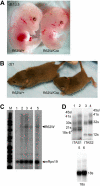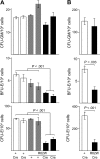A transgenic mouse model demonstrates a dominant negative effect of a point mutation in the RPS19 gene associated with Diamond-Blackfan anemia
- PMID: 20606162
- PMCID: PMC2974590
- DOI: 10.1182/blood-2010-03-275776
A transgenic mouse model demonstrates a dominant negative effect of a point mutation in the RPS19 gene associated with Diamond-Blackfan anemia
Abstract
Diamond Blackfan anemia (DBA) is an inherited erythroblastopenia associated with mutations in at least 8 different ribosomal protein genes. Mutations in the gene encoding ribosomal protein S19 (RPS19) have been identified in approximately 25% of DBA families. Most of these mutations disrupt either the translation or stability of the RPS19 protein and are predicted to cause DBA by haploinsufficiency. However, approximately 30% of RPS19 mutations are missense mutations that do not alter the stability of the RPS19 protein and are hypothesized to act by a dominant negative mechanism. To formally test this hypothesis, we generated a transgenic mouse model expressing an RPS19 mutation in which an arginine residue is replaced with a tryptophan residue at codon 62 (RPS19R62W). Constitutive expression of RPS19R62W in developing mice was lethal. Conditional expression of RPS19R62W resulted in growth retardation, a mild anemia with reduced numbers of erythroid progenitors, and significant inhibition of terminal erythroid maturation, similar to DBA. RNA profiling demonstrated more than 700 dysregulated genes belonging to the same pathways that are disrupted in RNA profiles of DBA patient cells. We conclude that RPS19R62W is a dominant negative DBA mutation.
Figures






Comment in
-
Finding a diamond in the (mouse is) rough.Blood. 2010 Oct 14;116(15):2623-5. doi: 10.1182/blood-2010-07-296780. Blood. 2010. PMID: 20947688
References
-
- Josephs HW. Anemia of infancy and early childhood. Medicine. 1936;15:307–451.
-
- Diamond LK, Blackfan KD. Hypoplastic anemia. Am J Dis Child. 1938;56:464–467.
-
- Willig TN, Niemeyer CM, Leblanc T, et al. Identification of new prognosis factors from the clinical and epidemiologic analysis of a registry of 229 Diamond-Blackfan anemia patients: DBA group of Société d'Hématologie et d'Immunologie pédiatrique (SHIP), Gesellshaft für Pädiatrische Onkologie und Hämatologie (GPOH), and the European Society for Pediatric Hematology and Immunology (ESPHI). Pediatr Res. 1999;46(5):553–561. - PubMed
-
- Ramenghi U, Garelli E, Valtolina S, et al. Diamond-Blackfan anemia in the Italian population. Br J Haematol. 1999;104(4):841–848. - PubMed
-
- Ball SE, McGuckin CP, Jenkins G, Gordon-Smith EC. Diamond-Blackfan anemia in the UK: analysis of 80 cases from a 20-year birth cohort. Br J Haematol. 1996;94(4):645–653. - PubMed
Publication types
MeSH terms
Substances
Grants and funding
LinkOut - more resources
Full Text Sources
Molecular Biology Databases
Miscellaneous

